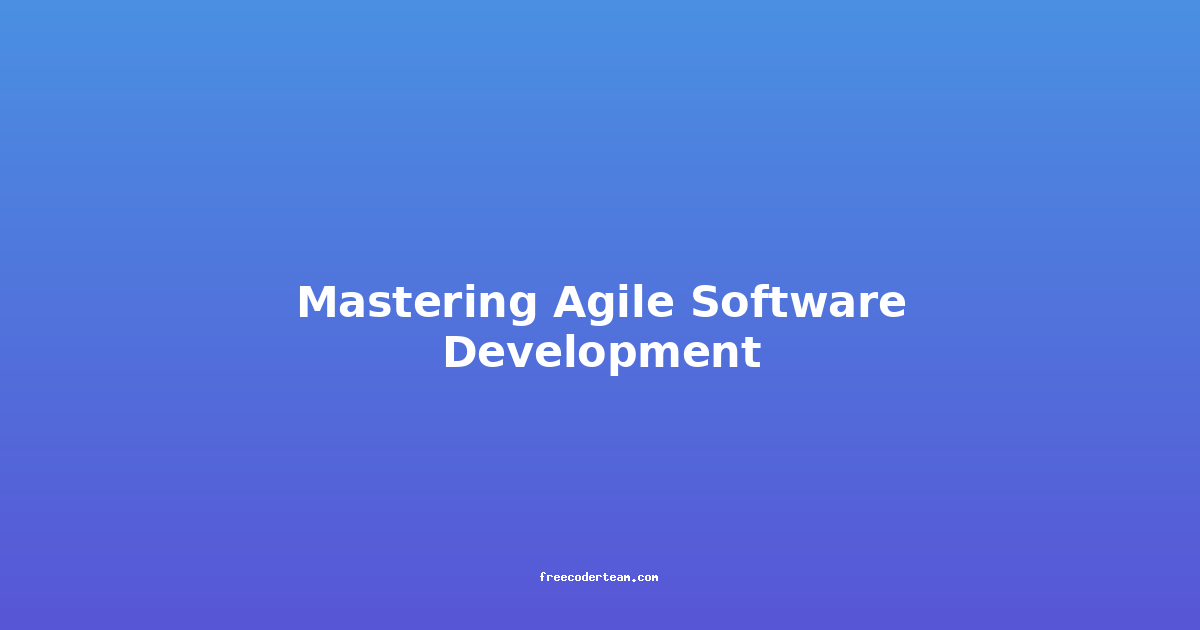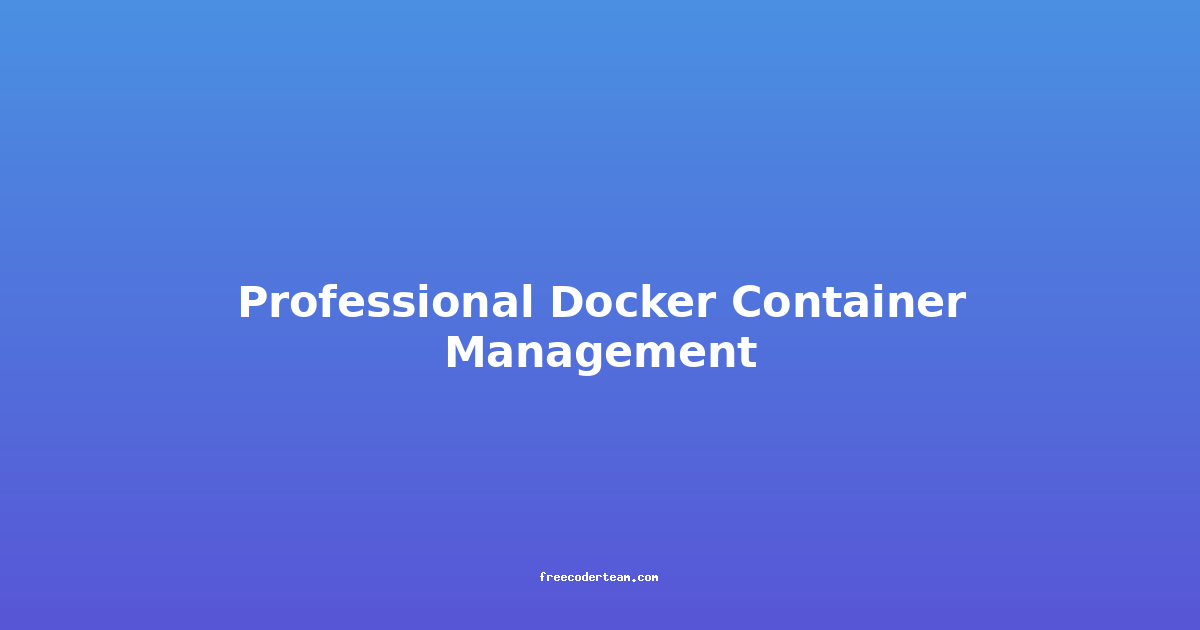Mastering Agile Software Development: A Comprehensive Guide
In today's fast-paced tech landscape, organizations are increasingly adopting Agile methodologies to deliver high-quality software products more efficiently. Agile software development is a flexible, iterative approach that prioritizes collaboration, adaptability, and delivering value to customers quickly. Whether you're a seasoned developer or a team lead, mastering Agile can transform how you approach software development.
This blog post will provide an in-depth look at Agile software development, including its core principles, best practices, practical examples, and actionable insights to help you implement Agile effectively.
What is Agile Software Development?
Agile is a methodology that emphasizes iterative development, customer collaboration, and flexibility. It was formalized in 2001 with the publication of the Agile Manifesto, which outlines four core values:
- Individuals and interactions over processes and tools.
- Working software over comprehensive documentation.
- Customer collaboration over contract negotiation.
- Responding to change over following a plan.
These values are supported by 12 principles, which guide teams in adopting Agile practices. The primary goal of Agile is to deliver value to customers in short cycles, allowing for continuous improvement and adaptation.
Key Agile Frameworks
While Agile is an umbrella term, several frameworks have emerged to operationalize its principles. The two most popular ones are:
1. Scrum
Scrum is a lightweight framework that divides work into time-boxed iterations called Sprints, typically lasting 1-4 weeks. Key roles in Scrum include:
- Product Owner: Responsible for defining product features and prioritizing the backlog.
- Development Team: A cross-functional team that delivers the product increment.
- Scrum Master: Facilitates the process and ensures the team follows Scrum principles.
2. Kanban
Kanban is a visual system for managing work flow. It uses a board with columns (e.g., To Do, In Progress, Done) to represent the status of tasks. Key principles include:
- Visualizing work to improve transparency.
- Limiting work in progress (WIP) to reduce bottlenecks.
- Continuous delivery by pulling work when capacity allows.
Core Principles of Agile
To master Agile, it's essential to understand its foundational principles:
1. Iterative Development
Agile breaks projects into smaller, manageable chunks called iterations. Each iteration produces a deliverable increment of the product. For example:
- Example: A mobile app development team might deliver a login feature in one sprint, followed by user profile management in the next.
2. Continuous Feedback
Agile emphasizes frequent feedback loops with stakeholders. This ensures the product aligns with customer needs. For instance:
- Example: After launching a new feature, the team collects user feedback and makes improvements in the next iteration.
3. Adaptability
Agile teams embrace change, even late in development. This allows them to respond to market shifts or new requirements effectively.
- Example: A feature planned for a sprint is replaced with a critical bug fix based on customer feedback.
Best Practices in Agile Software Development
1. Define Clear User Stories
User stories are concise descriptions of a feature from the end-user's perspective. They typically follow the format:
As a [user type], I want [feature], so that [reason].
- Example: "As a customer, I want to add items to my shopping cart, so that I can purchase multiple products at once."
User stories help ensure the team focuses on delivering value to the user.
2. Prioritize the Product Backlog
The Product Backlog is a prioritized list of features or tasks. Agile teams use techniques like MoSCoW (Must have, Should have, Could have, Won't have) to prioritize:
- Example: For a new e-commerce platform, "Secure Checkout" might be a "Must have," while "Social Media Integration" could be a "Could have."
3. Daily Stand-Ups
Daily stand-up meetings (also called Sprint Planning or Scrum Daily) are short, focused meetings where team members discuss:
-
What they worked on yesterday.
-
What they plan to work on today.
-
Any blockers or challenges.
-
Example: A developer might say, "Yesterday, I completed the login feature. Today, I'll work on fixing a bug. I'm blocked by a missing API endpoint."
4. Sprint Reviews and Retrospectives
At the end of each sprint, teams conduct two key meetings:
-
Sprint Review: Showcases completed work to stakeholders for feedback.
-
Sprint Retrospective: Reflects on what went well and what could be improved for the next sprint.
-
Example: In a sprint review, the team might demonstrate a new feature, and stakeholders provide feedback on usability.
Practical Examples of Agile in Action
Case Study 1: Feature Development for a SaaS Product
Imagine a Software-as-a-Service (SaaS) company developing a project management tool. They use Scrum to deliver new features.
Step 1: Define User Stories
The team creates user stories for a new "Task Assignment" feature:
As a project manager, I want to assign tasks to team members, so that I can track their progress.
Step 2: Sprint Planning
The team plans a 2-week sprint, breaking the task assignment feature into smaller tasks:
- Implement task assignment functionality.
- Add a notification system for assigned tasks.
- Test and validate the feature.
Step 3: Daily Stand-Ups
During daily meetings, the team discusses progress and identifies blockers. For example, if a developer is waiting for API documentation from another team, the Scrum Master helps resolve the issue.
Step 4: Sprint Review and Retrospective
At the end of the sprint, the team showcases the new feature to stakeholders. Feedback might include suggestions for improving the notification system, which the team addresses in the next sprint.
Case Study 2: Bug Fixes and Continuous Improvement
A team working on a mobile app receives frequent bug reports from users. Instead of a traditional waterfall approach, they use Agile to address issues quickly.
Approach
The team uses Kanban to manage bugs, prioritizing them based on severity:
- Critical Bugs: Fixed immediately.
- Medium Priority Bugs: Addressed in the next sprint.
- Low Priority Bugs: Scheduled for future sprints.
Outcome
By continuously addressing bugs and incorporating user feedback, the team maintains high customer satisfaction and improves the app's stability over time.
Actionable Insights for Agile Success
1. Foster a Collaborative Culture
Agile thrives in environments where team members feel comfortable sharing ideas and challenges. Encourage open communication and cross-functional collaboration.
2. Embrace Automation
Automation tools can streamline Agile processes, from continuous integration/continuous deployment (CI/CD) pipelines to task management platforms like Jira or Trello.
- Example: Use GitHub Actions for CI/CD to automate testing and deployment, reducing manual effort.
3. Focus on Delivering Value
Always prioritize features that provide the most value to users. Avoid gold-plating or over-engineering solutions.
- Example: Instead of building a complex feature that only 5% of users will use, focus on enhancing core functionalities that benefit the majority.
4. Measure Progress with Metrics
Track key metrics such as:
- Velocity: The amount of work completed in each sprint.
- Sprint Success Rate: Percentage of planned work delivered.
- Customer Feedback: Sentiment and bug reports.
These metrics help identify areas for improvement and ensure the team stays aligned with business goals.
Common Pitfalls and How to Avoid Them
Pitfall 1: Overcommitting in Sprints
Teams often overestimate their capacity, leading to incomplete sprints and frustrated stakeholders.
- Solution: Use historical data (e.g., past sprint velocities) to estimate how much work can be completed in a sprint.
Pitfall 2: Lack of Documentation
While Agile emphasizes working software over comprehensive documentation, some documentation is necessary for onboarding new team members or maintaining long-term clarity.
- Solution: Maintain lightweight documentation, such as README files, API documentation, or a knowledge base.
Pitfall 3: Poor Communication
Without clear communication, Agile teams can lose alignment or fail to address blockers effectively.
- Solution: Implement regular check-ins, such as daily stand-ups or ad-hoc meetings, to ensure everyone is on the same page.
Conclusion
Mastering Agile software development requires a commitment to collaboration, adaptability, and delivering value iteratively. By understanding its core principles, adopting best practices, and learning from practical examples, teams can unlock the full potential of Agile.
Remember, Agile is not a one-size-fits-all solution. It requires continuous learning and adjustment to suit your team's unique needs. By fostering a culture of transparency, feedback, and improvement, you can build high-performing Agile teams that deliver exceptional products.
With these insights and strategies, you're well-equipped to embrace Agile methodologies and drive success in your software development projects. Happy coding! 🚀
Disclaimer: The examples and insights provided are based on common Agile practices and may vary depending on team size, organizational culture, and project requirements.




